Morphology of Detrital Zircon as a Fingerprint to Trace Sediment Provenance: Case Study of the Yangtze Delta
Abstract
1. Introduction
2. Geological Setting
2.1. Yangtze River Drainage Basin
2.2. The Stratigraphy and Chronology of the Yangtze Delta
3. Materials and Methods
4. Results
4.1. Detrital Zircon Morphology Features of Core Sediment in the Yangtze Delta
4.2. Detrital Zircon Morphology Characteristics of the Modern Rivers
5. Discussion
5.1. Sediment Provenance of the Yangtze Delta in the Pliocene
5.2. Sediment Provenance Change in the Yangtze Delta during the Quaternary
6. Conclusions
Author Contributions
Funding
Acknowledgments
Conflicts of Interest
References
- Bianchi, T.S.; Allison, M.A. Large-river delta-front estuaries as natural “recorders” of global environmental change. PNAS 2009, 106, 8085–8092. [Google Scholar] [CrossRef]
- Bentley Sr, S.J.; Blum, M.D.; Maloney, J.; Pond, L.; Paulsell, R. The Mississippi River source-to-sink system: Perspectives on tectonic, climatic, and anthropogenic influences, Miocene to Anthropocene. Earth Sci. Rev. 2016, 153, 139–174. [Google Scholar] [CrossRef]
- Jin, B.F.; Wang, M.Y.; Yue, W.; Zhang, L.L.; Wang, Y.J. Heavy Mineral Variability in the Yellow River Sediments as Determined by the Multiple-Window Strategy. Minerals 2019, 9, 85. [Google Scholar] [CrossRef]
- Morton, A.C.; Hallsworth, C.R. Processes controlling the composition of heavy mineral assemblages in sandstones. Sediment. Geol. 1999, 124, 3–29. [Google Scholar] [CrossRef]
- Yang, S.Y.; Li, C.X.; Cai, J.G. Geochemical compositions of core sediments in eastern China: Implication for Late Cenozoic palaeoenvironmental changes. Palaeogeogr. Palaeoclimatol. Palaeoecol. 2006, 229, 287–302. [Google Scholar] [CrossRef]
- Gärtner, A.; Youbi, N.; Villeneuve, M.; Linnemann, U.; Sagawe, A.; Hofmann, M.; Zieger, J.; Mahmoudi, A.; Boumehdi, M.A. Palaeogeographic implications from the sediments of the Sebkha Gezmayet unit of the Adrar Souttouf Massif (Moroccan Sahara). Comptes Rendus Geosci. 2018, 350, 255–266. [Google Scholar] [CrossRef]
- Garzanti, E.; Andò, S. Heavy Minerals for Junior Woodchucks. Minerals 2019, 9, 148. [Google Scholar] [CrossRef]
- Schoene, B.; Samperton, K.M.; Eddy, M.P.; Keller, G.; Adatte, T.; Bowring, S.A.; Khadri, S.F.R.; Gertsch, B. U-Pb geochronology of the Deccan Traps and relation to the end-Cretaceous mass extinction. Science 2015, 347, 182–184. [Google Scholar] [CrossRef]
- Fielding, L.; Najman, Y.; Millar, I.; Butterworth, P.; Garzanti, E.; Vezzoli, G.; Barfod, D.; Kneller, B. The initiation and evolution of the River Nile. Earth Planet. Sci. Lett. 2018, 489, 166–178. [Google Scholar] [CrossRef]
- Augustsson, C.; Voigt, T.; Bernhart, K.; Kreißler, M.; Gaupp, R.; Gärtner, A.; Hofmann, M.; Linnemann, U. Zircon size-age sorting and source-area effect: The German Buntsandstein Group. Sediment. Geol. 2018, 375, 218–231. [Google Scholar] [CrossRef]
- Morton, A.; Ellis, D.; Fanning, M.; Jolley, D.; Whitham, A. The importance of an integrated approach to provenance studies: A case study from the Paleocene of the Faroe-Shetland Basin, NE Atlantic. Geol. Soc. Am. Spec. Pap. 2012, 487, 1–12. [Google Scholar]
- Garzanti, E. From static to dynamic provenance analysis—Sedimentary petrology upgraded. Sediment. Geol. 2016, 336, 3–13. [Google Scholar] [CrossRef]
- Gärtner, A.; Linnemann, U.; Sagawe, A.; Hofmann, M.; Ullrich, B.; Kleber, A. Morphology of zircon crystal grains in sediments–characteristics, classifications, definitions. Geol. Saxonica 2013, 59, 65–73. [Google Scholar]
- Salata, D. Advantages and limitations of interpretations of external morphology of detrital zircon: A case study of the Ropianka and Menilite formations (Skole Nappe, Polish Flysch Carpathians). Ann. Soc. Geol. Pol. 2014, 84, 153–165. [Google Scholar]
- Zoleikhaei, Y.; Frei, D.; Morton, A.; Zamanzadeh, S.M. Roundness of heavy minerals (zircon and apatite) as a provenance tool for unraveling recycling: A case study from the Sefidrud and Sarbaz rivers in N and SE Iran. Sediment. Geol. 2016, 342, 106–117. [Google Scholar] [CrossRef]
- Gärtner, A.; Youbi, N.; Villeneuve, M.; Sagawe, A.; Hofmann, M.; Mahmoudi, A.; Boumehdi, M.A.; Linnemann, U. The zircon evidence of temporally changing sediment transport—The NW Gondwana margin during Cambrian to Devonian time (Aoucert and Smara areas, Moroccan Sahara). Int. J. Earth Sci. 2017, 106, 2747–2769. [Google Scholar] [CrossRef]
- Resentini, A.; Ando, S.; Garzanti, E. Quantifying roundness of detrital minerals by image analysis: Sediment transport, shape effects, and provenance implications. J. Sediment. Res. 2018, 88, 276–289. [Google Scholar] [CrossRef]
- Miao, Y.F.; Zhang, P.; Lu, S.M.; Wu, X.Y.; Li, L.L.; Chen, H.G.; Li, X.Q.; Miao, Q.Y.; Feng, W.L.; Ou, J. Late Quaternary pollen records from the Yangtze River Delta, East China, and its implications for the Asian monsoon evolution. Arab. J. Geosci. 2015, 8, 7845–7854. [Google Scholar] [CrossRef]
- Wang, Z.H.; Saito, Y.; Zhan, Q.; Nian, X.M.; Pan, D.D.; Wang, L.; Chen, T.; Xie, J.L.; Li, X.; Jiang, X.Z. Three-dimensional evolution of the Yangtze River mouth, China during the Holocene: Impacts of sea level, climate and human activity. Earth Sci. Rev. 2018, 185, 938–955. [Google Scholar] [CrossRef]
- Fan, D.D.; Li, C.X. Timing of the Yangtze initiation draining the Tibetan Plateau throughout to the East China Sea: A review. Front. Earth Sci. 2008, 2, 302–313. [Google Scholar] [CrossRef]
- Jia, J.T.; Zheng, H.B.; Huang, X.T.; Wu, F.Y.; Yang, S.Y.; Wang, K.; He, M.Z. Detrital zircon U-Pb ages of late Cenozoic sediments from the Yangtze Delta, Implication for the evolution of the Yangtze River. Chin. Sci. Bull. 2010, 55, 1520–1528. [Google Scholar] [CrossRef]
- Liu, X.B. Magnetic properties of late Cenozoic sediments in south and north flanks of the Yangtze delta: Source-sink implications for river’s connection to the sea. Ph.D. Dissertation, East China Normal University, Shanghai, China, 2017; pp. 43–47, (In Chinese with English abstract). [Google Scholar]
- Liu, X.B.; Chen, J.; Maher, B.A.; Zhao, B.C.; Yue, W.; Sun, Q.L.; Chen, Z.Y. Connection of the proto-Yangtze River to the East China Sea traced by sediment magnetic properties. Geomorphology 2018, 303, 162–171. [Google Scholar] [CrossRef]
- Huang, X.T.; Zheng, H.B.; Yang, S.Y.; Xie, X. Investigation of sedimentary geochemistry of core DY03 in the Yangtze Delta: Implication to tracing provenance. Quat. Sci. 2009, 29, 299–307, (In Chinese with English abstract). [Google Scholar]
- Fan, D.D.; Li, C.X.; Yokoyama, K.; Zhou, B.C.; Li, B.H.; Wang, Q.; Yang, S.Y.; Deng, B.; Wu, G.X. Monazite age spectra in the Late Cenozoic strata of the Changjiang delta and its implication on the Changjiang run-through time. Sci. China Ser. D Earth Sci. Engl. Ed. 2005, 48, 171–1727. [Google Scholar] [CrossRef]
- Yue, W.; Liu, J.T.; Zhang, D.; Wang, Z.H.; Zhao, B.C.; Chen, Z.Y.; Chen, J. Magnetite with anomalously high Cr2O3 as a fingerprint to trace upper Yangtze sediments to the sea. Geomorphology 2016, 268, 14–20. [Google Scholar] [CrossRef]
- Yue, W.; Jin, B.F.; Zhao, B.C. Transparent heavy minerals and magnetite geochemical composition of the Yangtze River sediments: Implication for provenance evolution of the Yangtze Delta. Sediment. Geol. 2018, 364, 42–52. [Google Scholar] [CrossRef]
- Chen, J.; Wang, Z.H.; Chen, Z.Y.; Wei, Z.X.; Wei, T.Y.; Wei, W. Diagnostic heavy minerals in Plio–Pleistocene sediments of the Yangtze Coast, China with special reference to the Yangtze River connection into the sea. Geomorphology 2009, 113, 129–136. [Google Scholar] [CrossRef]
- Wang, Z.H.; Zhang, D.; Li, X.; Tao, S.K.; Xie, Y. Magnetic properties and relevant minerals of late Cenozoic sediments in the Yangtze River delta and their implications. Geol. China 2008, 35, 670–680, (In Chinese with English abstract). [Google Scholar]
- Schneiderman, J.S.; Chen, Z.Y.; Eckert, J.O. Heavy minerals and river channel migration in the Yangtze delta plain, Eastern China. J. Coast. Res. 2003, 19, 326–335. [Google Scholar]
- Changjiang Water Resources Commission. Changjiang Sediment Bulletin in 2017; Changjiang Press: Wuhan, China, 2017. (In Chinese) [Google Scholar]
- He, M.Y.; Zheng, H.B.; Clift, P.D. Zircon U-Pb geochronology and Hf isotope data from the Yangtze River sands: Implications for major magmatic events and crustal evolution in Central China. Chem. Geol. 2013, 360, 186–203. [Google Scholar] [CrossRef]
- Chen, Z.Y.; Li, J.F.; Shen, H.T.; Wang, Z.H. Yangtze River of China: Historical analysis of discharge variability and sediment flux. Geomorphology 2001, 41, 77–91. [Google Scholar] [CrossRef]
- Ma, L.F.; Qiao, X.F.; Liu, N. Geological Atlas of China; Geological Publishing House: Beijing, China, 2002; (In Chinese with English abstract). [Google Scholar]
- Wang, Z.J.; Chen, Z.Y.; Wei, Z.X.; Wang, Z.H.; Wei, T.Y. Coupling controls of neotectonism and paleoclimate on the Quaternary sediments of the Yangtze (Changjiang) coast. Chin. Sci. Bull. 2005, 50, 1775–1784. [Google Scholar] [CrossRef]
- Deng, C.W.; Zhang, X.; Lin, C.M.; Xu, Z.Y.; Yu, J. Grain size analysis and environmental evolution indicated by the ZK01 borehole samples in the Changjiang delta since the latest glacial maximum. Sediment. Geol. Tethyan Geol. 2016, 17, 37–46, (In Chinese with English abstract). [Google Scholar]
- Mange, M.A.; Maurer, H.F.W. Heavy Minerals in Colour; Chapman and Hall: London, UK, 1992; pp. 135–151. [Google Scholar]
- Cox, E.P. A method of assigning numerical and percentage values to the degree of roundness of sand grains. J. Paleontol. 1927, 1, 179–183. [Google Scholar]
- Powers, M.C. A new roundness scale for sedimentary particles. J. Sediment. Res. 1953, 23, 117–119. [Google Scholar] [CrossRef]
- Poldervaart, A. Zircons in Rocks; 1. Sedimentary Rocks. Am. J. Sci. 1955, 253, 433–461. [Google Scholar] [CrossRef]
- Poldervaart, A. Zircons in Rocks; 2. Igneous Rocks. Am. J. Sci. 1956, 254, 521–554. [Google Scholar] [CrossRef]
- Osorio-Granada, E.; Restrepo-Moreno, S.A.; Muñoz-Valencia, J.A.; Trejos-Tamayo, R.A.; Pardo-Trujillo, A.; Barbosa-Espitia, A.A. Detrital zircon typology and U/Pb geochronology for the Miocene Ladrilleros-Juanchaco sedimentary sequence, Equatorial Pacific (Colombia): New constraints on provenance and paleogeography in northwestern South America. Geol. Acta 2017, 15, 201–215. [Google Scholar]
- Pupin, J.P. Zircon and granite petrology. Contrib. Mineral. Petr. 1980, 73, 207–220. [Google Scholar] [CrossRef]
- Corfu, F.; Hanchar, J.M.; Hoskin, P.W.O.; Kinny, P. Atlas of zircon textures. Rev. Mineral. Geochem. 2003, 53, 469–500. [Google Scholar] [CrossRef]
- Chen, Z.Y.; Stanley, D.J. Quaternary subsidence and river channel migration in the Yangtze Delta plain, Eastern China. J. Coast. Res. 1995, 11, 927–945. [Google Scholar]
- Yue, W.; Yang, S.Y.; Zhao, B.C.; Chen, Z.Y.; Yu, J.J.; Liu, X.B.; Huang, X.T.; Jin, B.F.; Chen, J. Changes in environment and provenance within the Changjiang (Yangtze River) Delta during Pliocene to Pleistocene transition. Mar. Geol. 2019, 416, 105976. [Google Scholar] [CrossRef]
- Fedo, C.M.; Sircombe, K.N.; Rainbird, R.H. Detrital zircon analysis of the sedimentary record. Rev. Mineral. Geochem. 2003, 53, 277–303. [Google Scholar] [CrossRef]
- Nie, J.S.; Horton, B.K.; Saylor, J.E.; Mora, A.; Mange, M.; Garzione, C.N.; Basu, A.; Moreno, C.J.; Caballero, V.; Parra, M. Integrated provenance analysis of a convergent retroarc foreland system: U-Pb ages, heavy minerals, Nd isotopes, and sandstone compositions of the Middle Magdalena Valley basin, northern Andes, Colombia. Earth Sci. Rev. 2012, 110, 111–126. [Google Scholar] [CrossRef]
- Cascalho, J. Provenance of Heavy Minerals: A Case Study from the WNW Portuguese Continental Margin. Minerals 2019, 9, 355. [Google Scholar] [CrossRef]
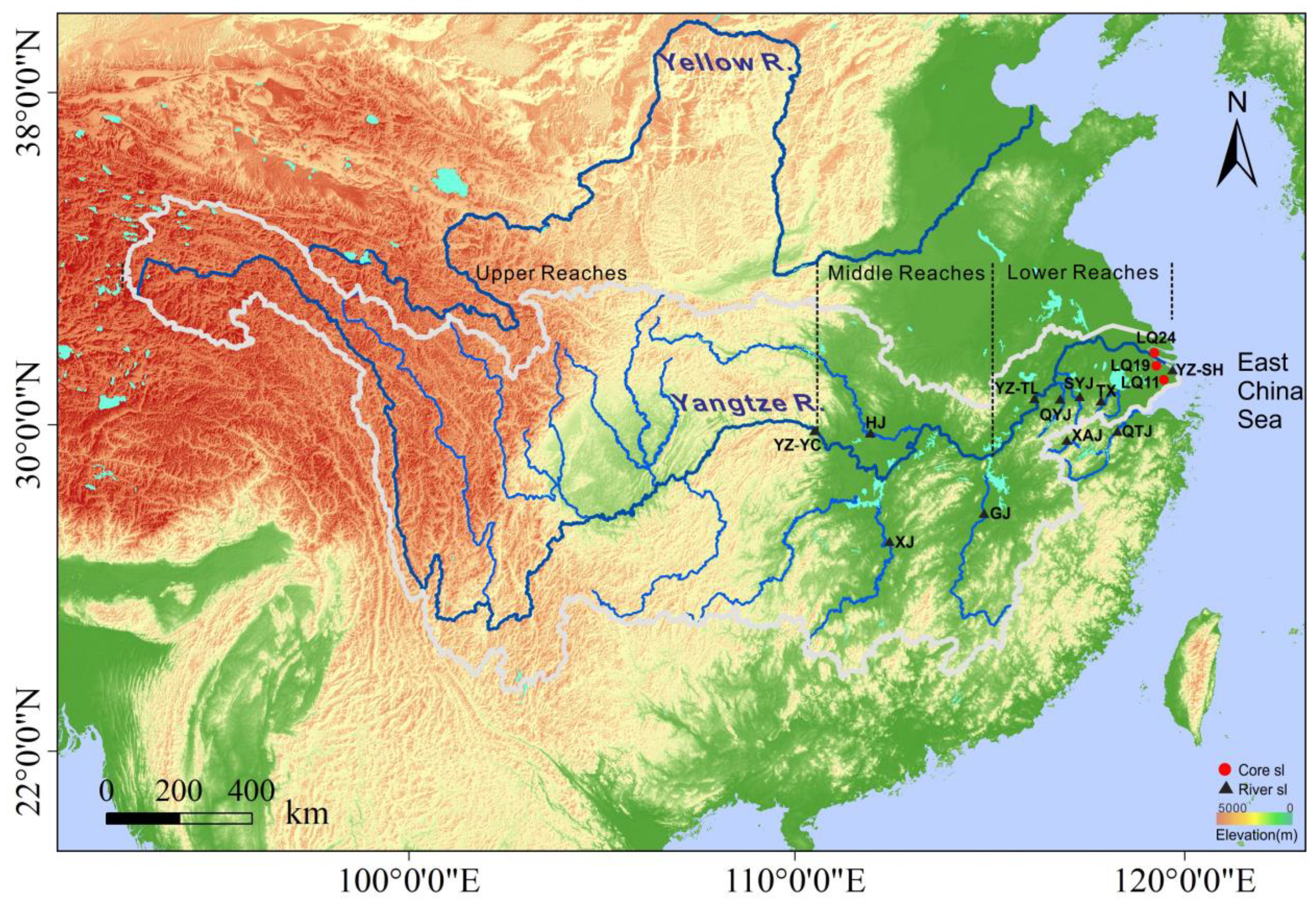
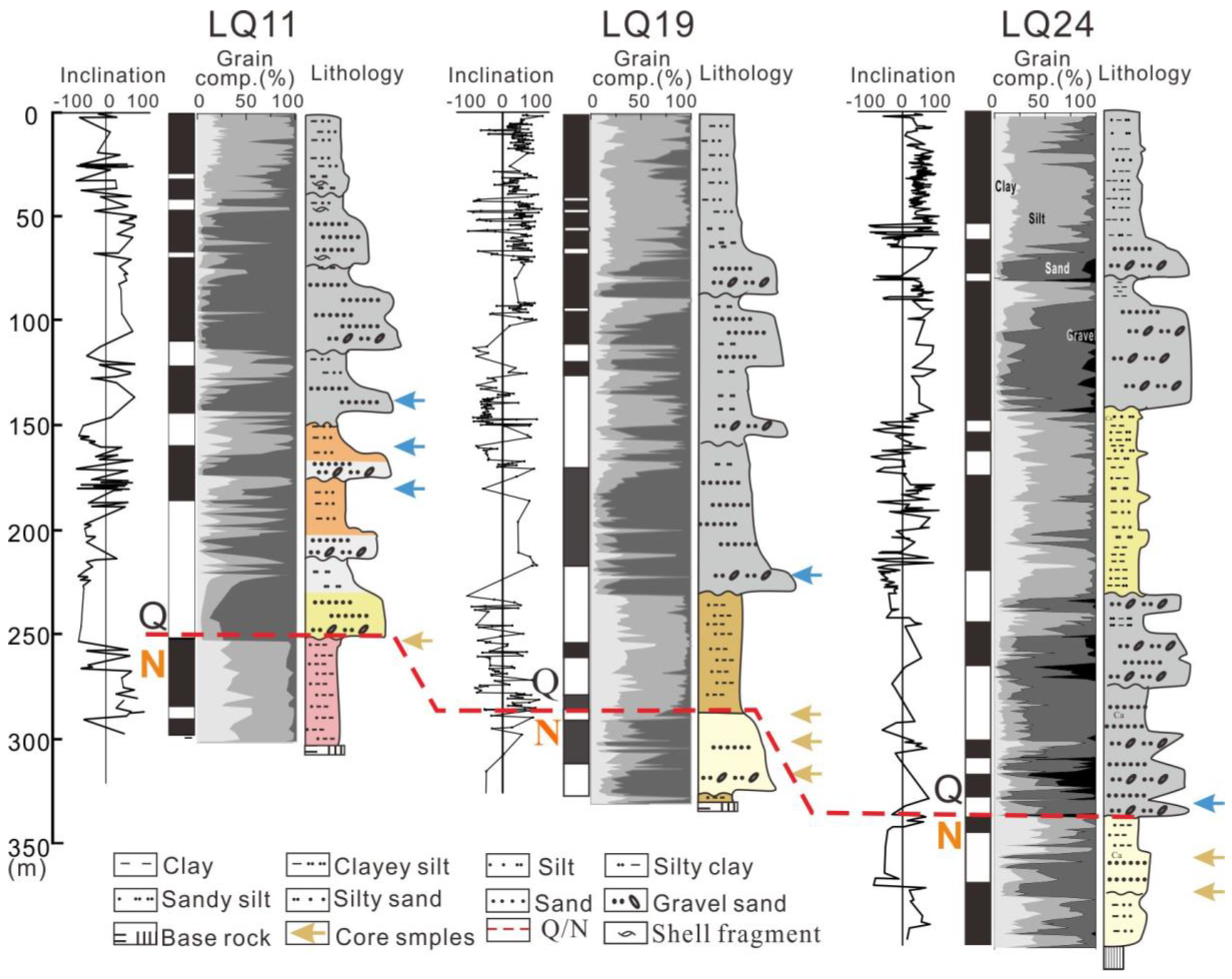
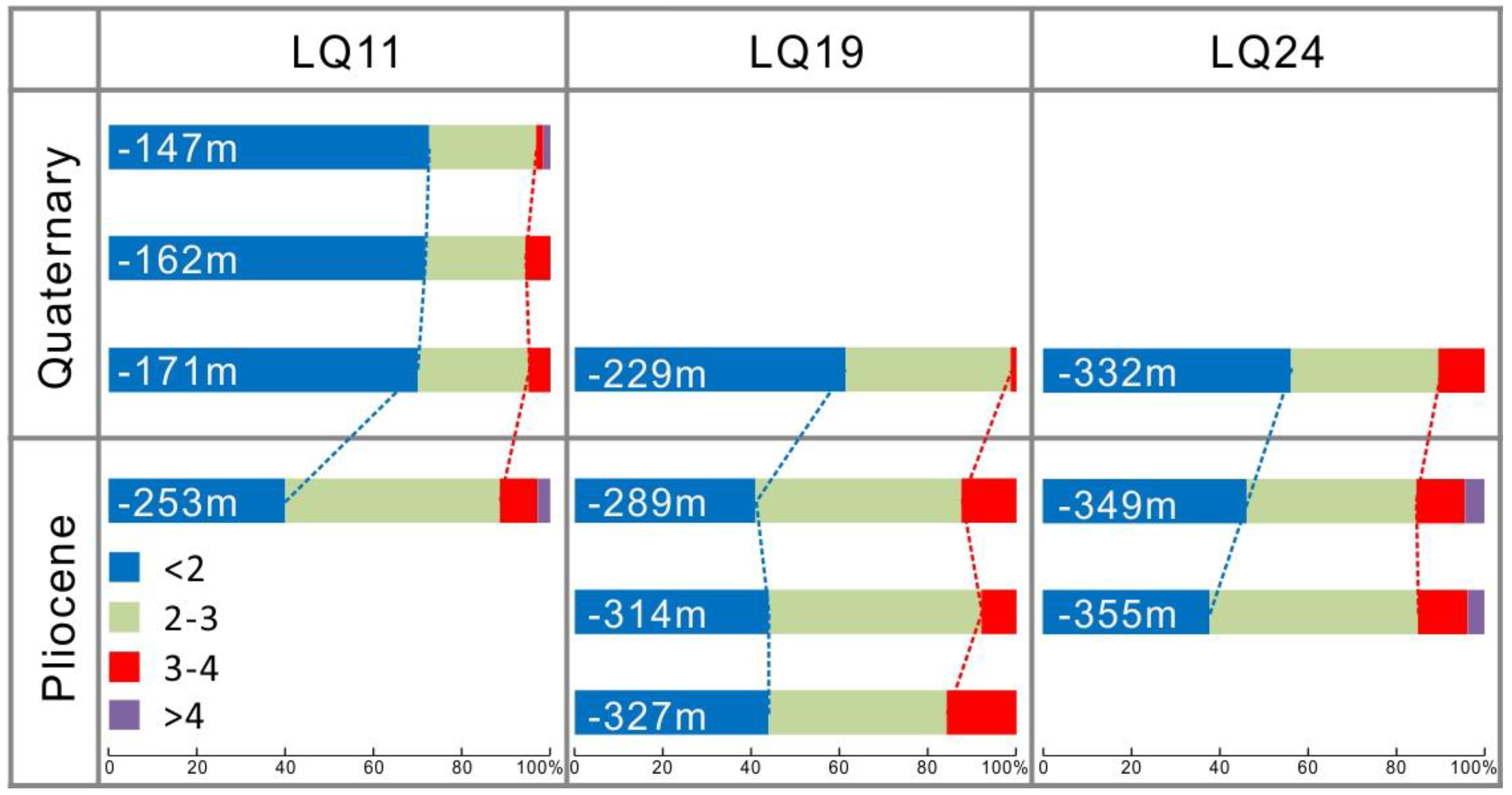
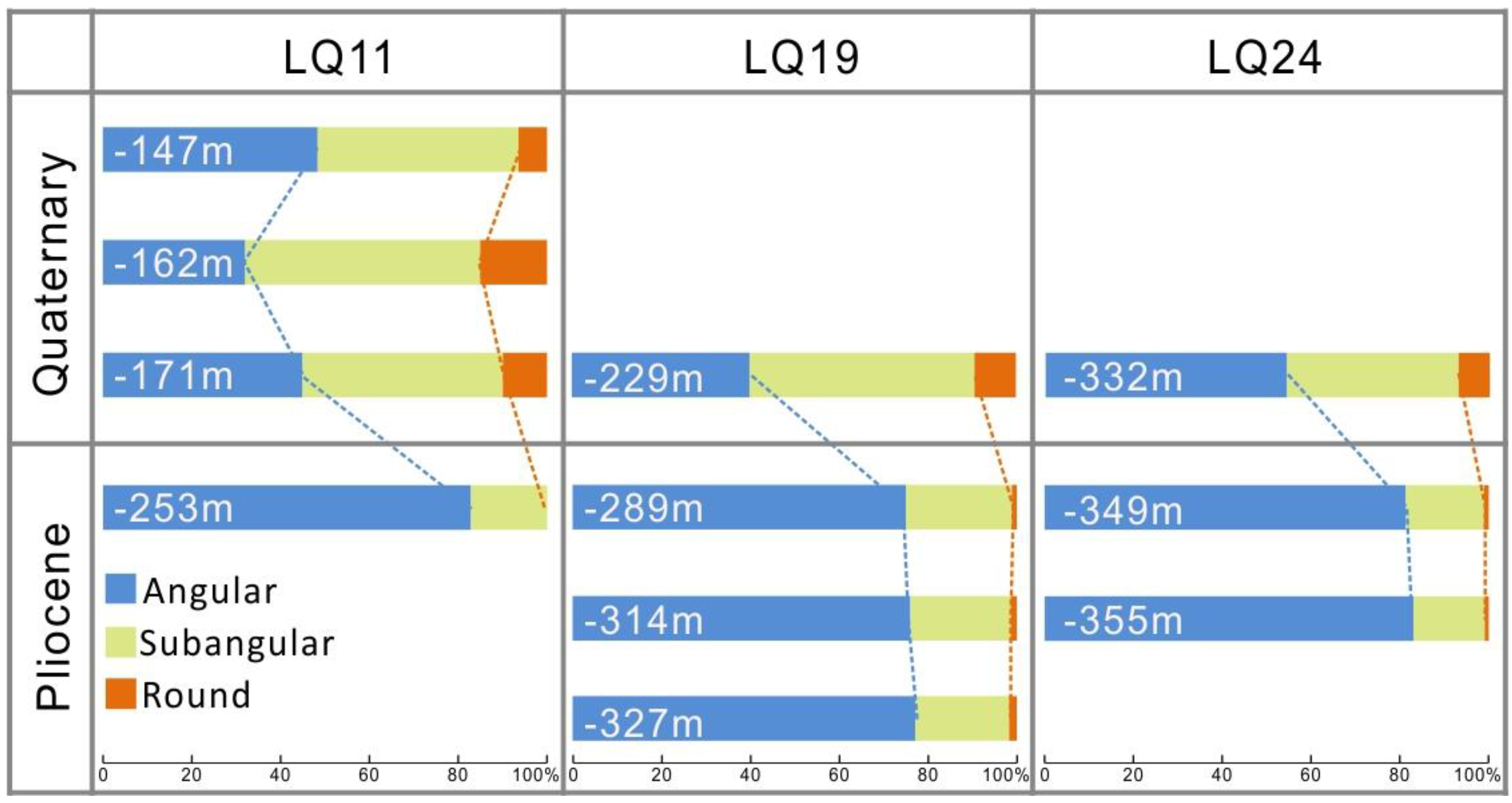
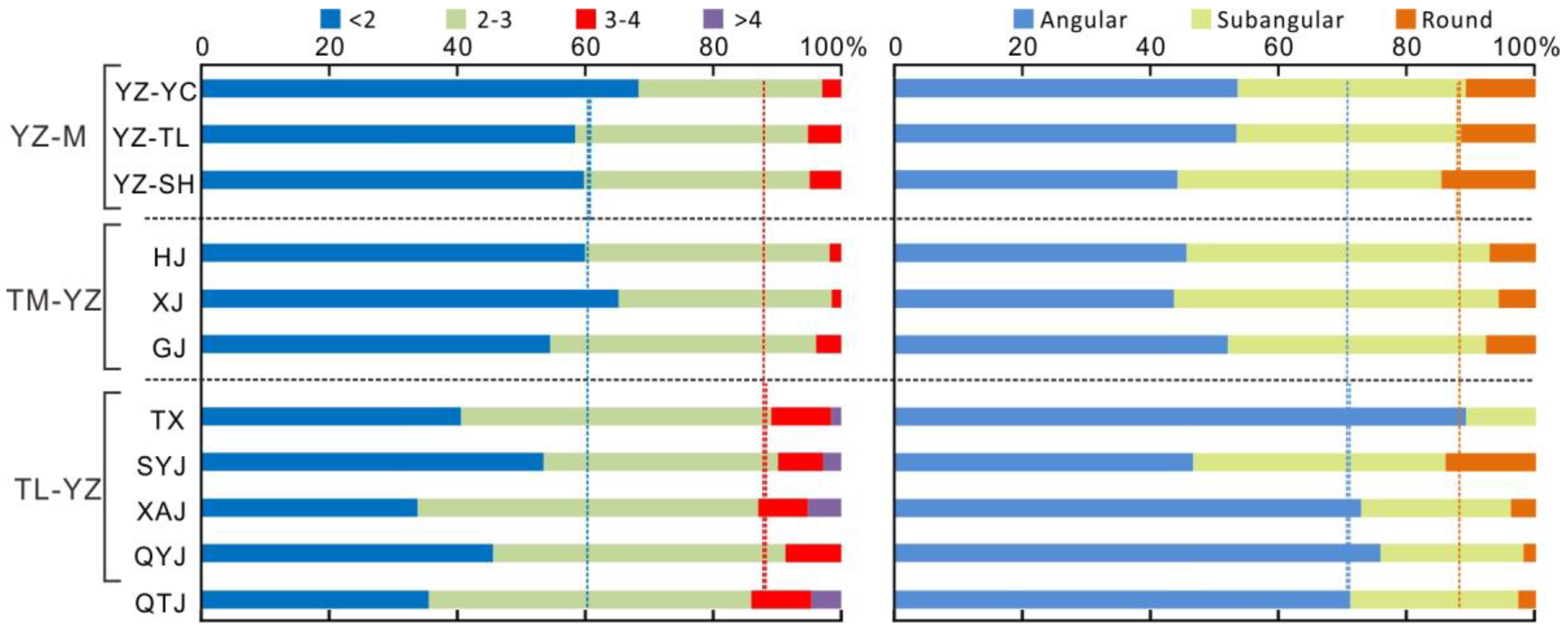
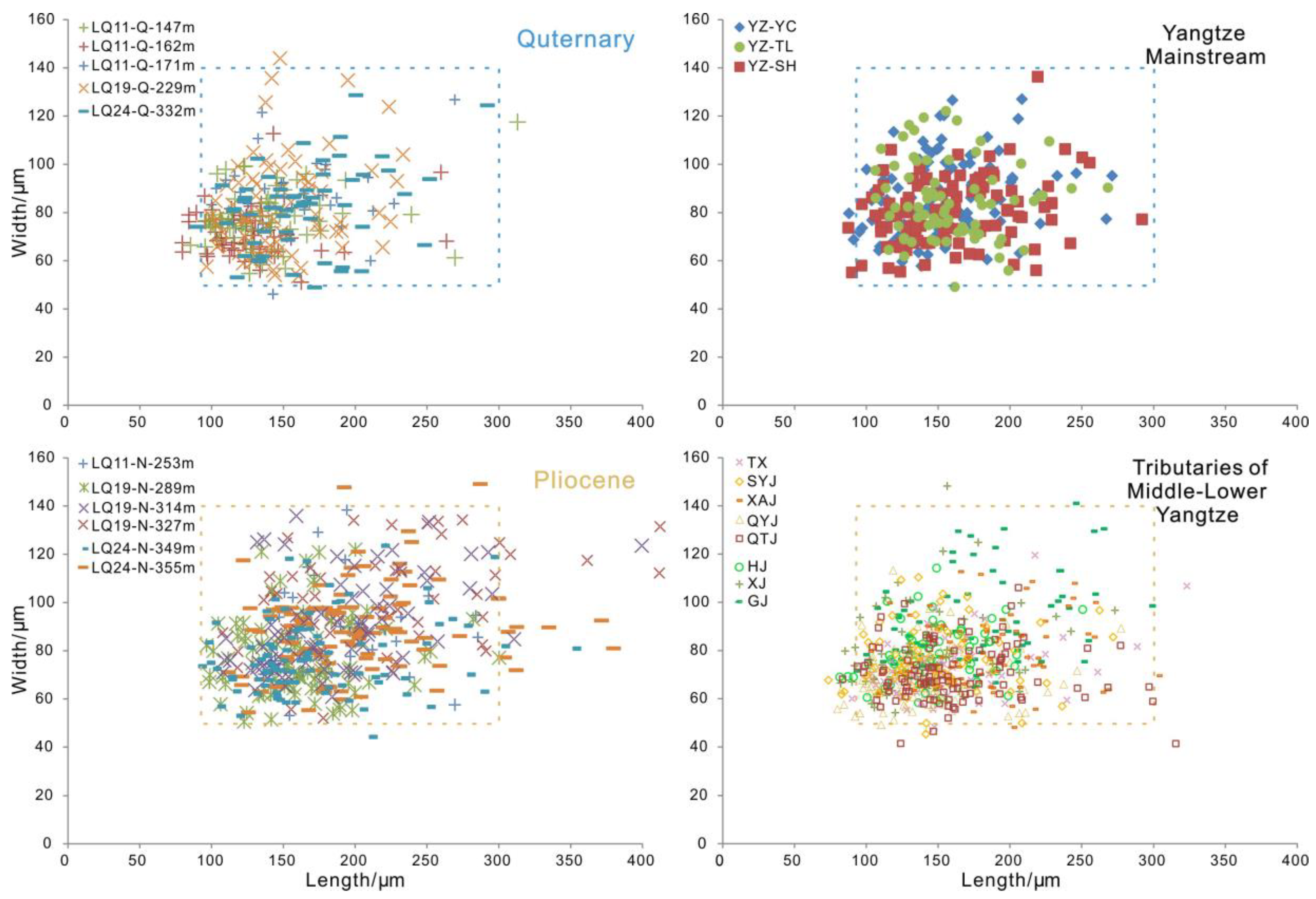

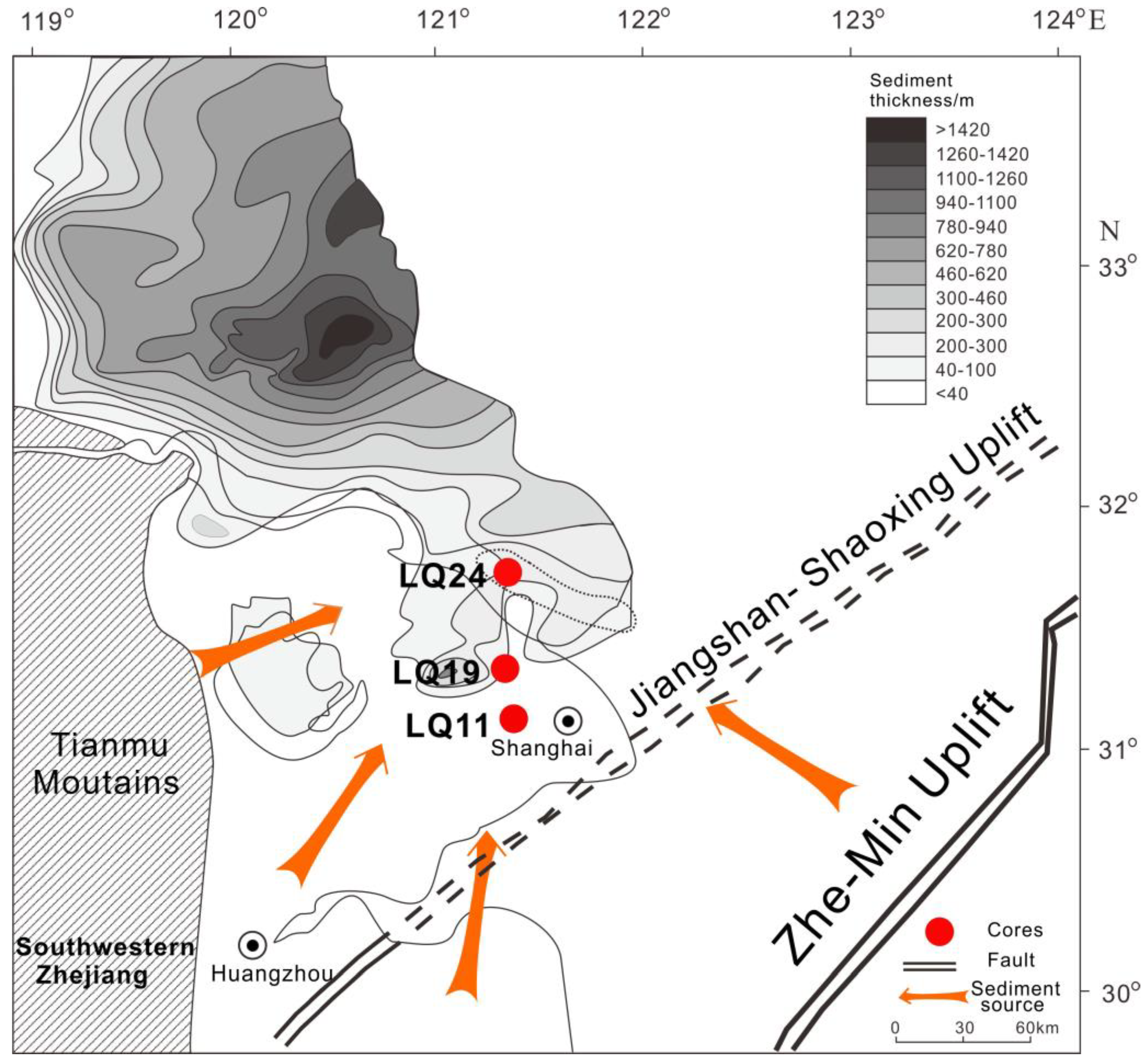
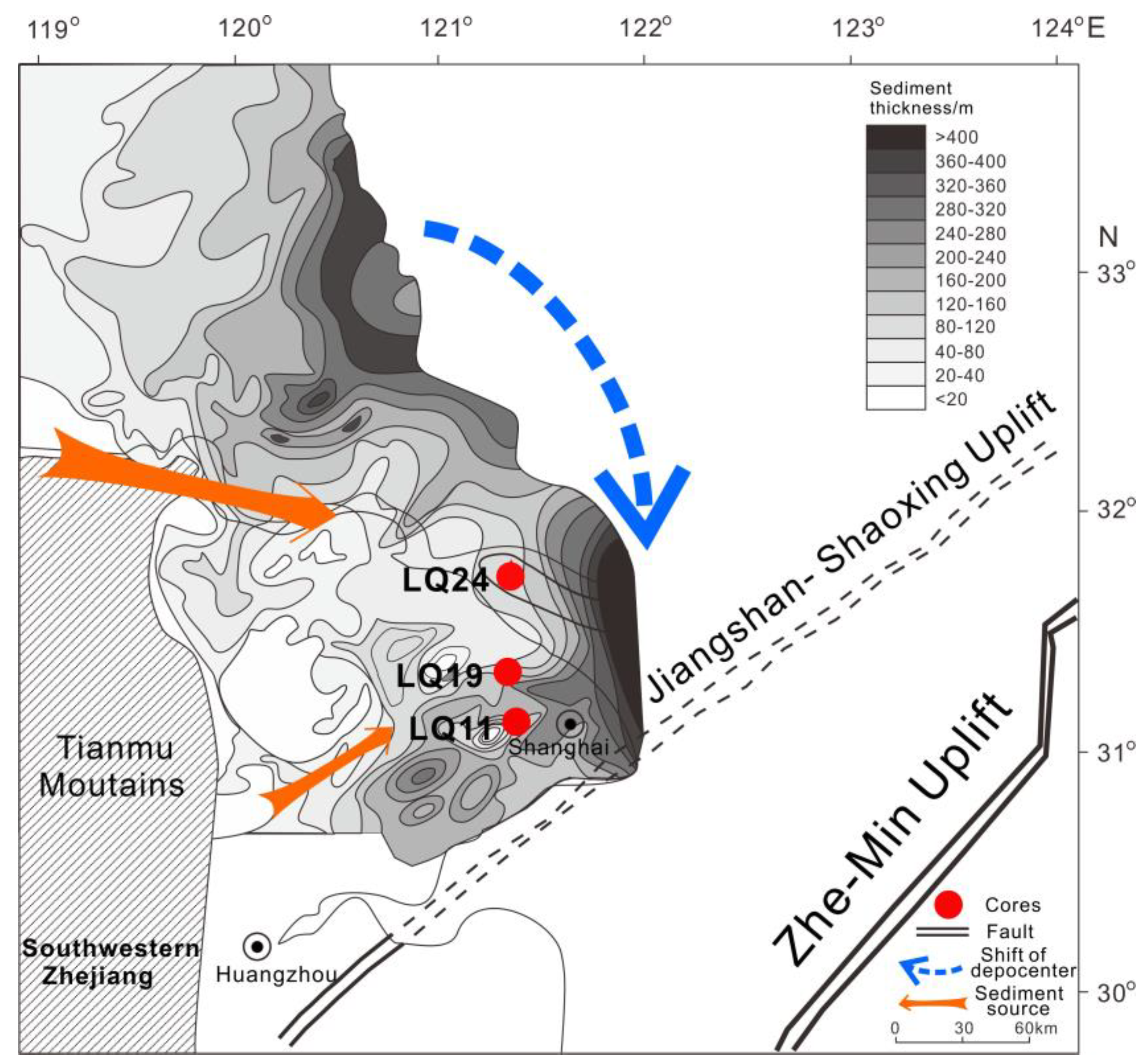
| Location | Samples (No) | Elongation (%) | Roundness (%) | Standard Deviation | ||||||||
|---|---|---|---|---|---|---|---|---|---|---|---|---|
| <2 | 2–3 | 3–4 | >4 | >3 | Angular | Subangular | Rounded | Length | Width | Elongation | ||
| SYZD | LQ11-Q-147 m (63) | 71.4 | 25.4 | 1.6 | 1.6 | 3.2 | 47.6 | 46.1 | 6.3 | 39.6 | 11.6 | 0.5 |
| LQ11-Q-162 m (52) | 71.1 | 23.1 | 5.8 | 0.0 | 5.8 | 32.7 | 51.9 | 15.4 | 35.6 | 10.3 | 0.6 | |
| LQ11-Q-171 m (40) | 70.0 | 25.0 | 5.0 | 0.0 | 5.0 | 45.0 | 45.0 | 10.0 | 37.0 | 14.3 | 0.5 | |
| LQ11-N-253 m (35) | 40.0 | 48.6 | 8.6 | 2.9 | 11.5 | 82.9 | 17.1 | 0.0 | 41.0 | 18.8 | 0.7 | |
| MYZD | LQ19-Q-229 m (75) | 61.3 | 37.3 | 1.3 | 0.0 | 1.3 | 40.0 | 50.7 | 9.3 | 33.5 | 19.6 | 0.5 |
| LQ19-N-289 m (88) | 40.9 | 46.6 | 12.5 | 0.0 | 12.5 | 75.0 | 23.9 | 1.1 | 39.1 | 16.3 | 0.6 | |
| LQ19-N-314 m (75) | 44.0 | 48.0 | 8.0 | 0.0 | 8.0 | 76.0 | 22.7 | 1.3 | 53.6 | 19.1 | 0.5 | |
| LQ19-N-327 m (57) | 43.9 | 40.4 | 15.8 | 0.0 | 15.8 | 77.2 | 21.1 | 1.8 | 69.6 | 20.0 | 0.7 | |
| NYZD | LQ24-Q-332 m (57) | 56.1 | 33.3 | 10.5 | 0.0 | 10.5 | 54.4 | 38.6 | 7.0 | 39.6 | 17.2 | 0.6 |
| LQ24-N-349 m (91) | 46.2 | 38.5 | 11.0 | 4.4 | 15.4 | 81.3 | 17.6 | 1.1 | 51.7 | 15.8 | 0.8 | |
| LQ24-N-355 m (106) | 37.7 | 47.2 | 11.3 | 3.8 | 15.1 | 83.0 | 16.0 | 0.9 | 53.1 | 17.7 | 0.7 | |
| YZ-M | YZ-YC (101) | 68.3 | 28.7 | 3.0 | 0.0 | 3.0 | 53.5 | 35.6 | 10.9 | 36.2 | 15.4 | 0.5 |
| YZ-TL (77) | 58.4 | 36.4 | 5.2 | 0.0 | 5.2 | 53.2 | 35.1 | 11.7 | 33.0 | 15.7 | 0.6 | |
| YZ-SH (102) | 59.8 | 35.3 | 4.9 | 0.0 | 4.9 | 44.1 | 41.2 | 14.7 | 41.9 | 13.9 | 0.6 | |
| TM-YZ | GJ (77) | 54.5 | 41.6 | 3.9 | 0.0 | 3.9 | 51.9 | 40.3 | 7.8 | 45.8 | 18.4 | 0.5 |
| XJ (69) | 65.2 | 33.3 | 1.4 | 0.0 | 1.4 | 43.5 | 50.7 | 5.8 | 38.1 | 16.9 | 0.5 | |
| HJ (55) | 60.0 | 38.2 | 1.8 | 0.0 | 1.8 | 45.5 | 47.3 | 7.3 | 32.8 | 12.3 | 0.5 | |
| TL-YZ | TX (64) | 40.6 | 48.4 | 9.4 | 1.6 | 11.0 | 89.1 | 10.9 | 0.0 | 43.3 | 12.5 | 0.6 |
| QYJ (103) | 45.6 | 45.6 | 8.7 | 0.0 | 8.7 | 75.7 | 22.3 | 1.9 | 37.0 | 11.4 | 0.6 | |
| XAJ (77) | 33.8 | 53.2 | 7.8 | 5.2 | 13.0 | 72.7 | 23.4 | 3.9 | 41.7 | 14.2 | 0.7 | |
| SYJ (71) | 53.5 | 36.6 | 7.0 | 2.8 | 9.8 | 46.5 | 39.4 | 14.1 | 39.7 | 13.5 | 0.7 | |
| Qiantang | QTJ (107) | 35.5 | 50.5 | 9.3 | 4.7 | 14.0 | 71.0 | 26.2 | 2.8 | 44.8 | 11.5 | 0.9 |
© 2019 by the authors. Licensee MDPI, Basel, Switzerland. This article is an open access article distributed under the terms and conditions of the Creative Commons Attribution (CC BY) license (http://creativecommons.org/licenses/by/4.0/).
Share and Cite
Yue, W.; Yue, X.; Zhang, L.; Liu, X.; Song, J. Morphology of Detrital Zircon as a Fingerprint to Trace Sediment Provenance: Case Study of the Yangtze Delta. Minerals 2019, 9, 438. https://doi.org/10.3390/min9070438
Yue W, Yue X, Zhang L, Liu X, Song J. Morphology of Detrital Zircon as a Fingerprint to Trace Sediment Provenance: Case Study of the Yangtze Delta. Minerals. 2019; 9(7):438. https://doi.org/10.3390/min9070438
Chicago/Turabian StyleYue, Wei, Xiyuan Yue, Lingmin Zhang, Xianbin Liu, and Jian Song. 2019. "Morphology of Detrital Zircon as a Fingerprint to Trace Sediment Provenance: Case Study of the Yangtze Delta" Minerals 9, no. 7: 438. https://doi.org/10.3390/min9070438
APA StyleYue, W., Yue, X., Zhang, L., Liu, X., & Song, J. (2019). Morphology of Detrital Zircon as a Fingerprint to Trace Sediment Provenance: Case Study of the Yangtze Delta. Minerals, 9(7), 438. https://doi.org/10.3390/min9070438




